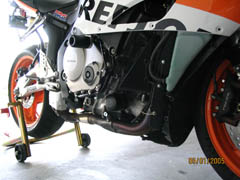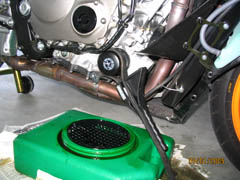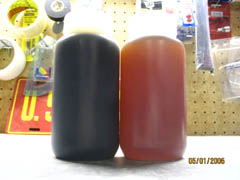
Honda CBR 1000RR Oil Change
Updated October 2006
I will not go into the importance of regular oil changes. If you purchased a $11,000.00 machine I hope you know that much already. What I will discuss here is how to change the oil easily, and with as little mess as possible. I've also done A LOT of research on oils and oil filters and will post information in future articles that explain in more detail the reasoning behind the choices I have made for the oil and oil filter I use on my 1000RR. After comparing oil analysis of several oils I've determined that the Repsol 4T Racing 10W-50 is the best for these motorcycles along with a Mobil 1 M1-108 oil filter. At around $9.00 US per quart the Repsol 4T Racing 10W-50 is more expensive than the stock Pro Honda GN4 10W 40 SJ, however it is better oil so it meets my "bang for the buck" requirements. Keep in mind this is Repsol's top of the line product. They also offer other grades of oil as well that cost less. For more information visit www.repsolypf.com. Prior to the oil analysis results I used Mobil 1 15W-50 EP and that oil would be a good choice as well. The Repsol quart containers also have a nice pour spout which makes filling the crank case a cinch and mess free.

The M1-108 oil filter has the same thread (20 x 1.5mm) and is the same size as the stock Honda filter (15410-MCJ-003). Mobil 1's filter is a MUCH better filter than the stock Honda offering and is about the same price at $10.00 US. I've done a lot of research to determine M1-108 filter will work fine on the 1000RR; however it is NOT sold as a motorcycle filter, so make your own judgment on using this filter. This Mobil 1 filter has a 11-17 psi bypass valve where the stock filter is 8 psi making them very close as far as the pressure required to initiate filter bypass. Bypass is important as it's what will save your motor should the filter become clogged, or if the oil pressure should have an issue. The M1-108 has synthetic filter media that has a 10-20 micron 98% efficiency rating for single pass and a 10-20 micron 95% efficiency rating for multi pass. This is excellent filtering ability as the average filter is about 80% efficient at 20 microns. I tried to find out what the stock Honda oil filter efficiency was, but was told they out source the filter yearly, and no one I spoke with had any idea what the current efficiency is. Note that Mobil 1 has changed the color of the oil filter canister, thus the difference in the two pictures below. The new color is black.
|
|
|
I typically ride 5,000 miles per season. I've used 5,000 mile (8,045 Km) oil change intervals on my bikes (as well as my cars) even though the manual recommends 8,000 mile (12,872 Km) intervals. I've sent regular non-synthetic oil off for analysis after 5,000 miles from my cars and it's still fine. Motorcycles rev higher and will shear oil more so than an automobile, so keep an eye on that in your analysis reports to determine the best interval for you. The things I look for in an analysis report to check the oil change interval is the viscosity at 100C and the TBN. The Repsol changed from a 50W viscosity to a 30W over 5,000 miles. The TBN was still OK. This tells me that the interval was a tad long, and I've now gone to a 4,000 mile interval in this bike with the Repsol 4T Racing, or once a season, whichever comes first. This will usually work out to once a season for me. A great oil resource is http://www.bobistheoilguy.com. If you want to understand oil, this is the place to read up.
The entire oil change is a little pricey at around $50.00 US, but that's only $50.00 per year since I only ride enough miles to warrant one oil change per year. It's worth the extra cost to have the engine protected while it's stored for the winter. The good TBN of Repsol 4T insures the oil doesn't become acidic over the winter storage period. I highly recommend oil analysis if you want to check me on these facts. Oil Analyzers is a great place to have this done. You can get information from them at www.oaitesting.com. It doesn't hurt to have your oil tested once a year regardless as this will let you know ahead of time if your motor is having any issues.
To change the oil in the 1000RR begin by taking it for a ride to get it up to operating temperature which is 180F to 210F (82C to 99C). Letting it idle in the driveway will not be good enough as the oil needs to pass around the clutch plates, so be sure to take it for a ride that will allow all of the gears to be used. Once the ride is complete park the machine on level ground and allow it to cool for about 15 or 20 minutes. The oil drain plug is in between the header pipes on the front of the engine and these become extremely hot. You can go ahead and remove the right lower body panel while the cooling is taking place. The right lower is held on by 6 - 5mm button head hex bolts, 3 plastic tabs, and 4 plastic phillips screw type tabs.
 |
Next, place a few news papers on the floor directly underneath the bike. Place an appropriate container to catch the used oil on top of the papers slightly ahead of the oil drain bolt. Remove the 12mm drain bolt located between the header down pipes. It's a little tricky, but try to keep your hand out of the way of the oil stream as it comes out and don't drop the oil drain bolt or you'll be fishing for it in the used oil container. The oil will shoot out about 6 inches when the drain bolt is initially removed so be prepared for that. After a few seconds reposition the container so that it catches the oil as the stream lessens. It takes about 5 minutes for all of the oil to drain. If you don't have some type of stand that will let the machine sit upright, then I recommend standing the bike up off the side stand to allow the oil to drain completely. Once it's down to just a drip, wipe off the drain bolt area as well as the drain bolt threads. Apply a light coat of fresh oil to the drain bolt threads and put it back into the bike tightening to 22 ft. lbs. (29 Nm). I couldn't get my torque wrench to fit in between the header pipes, so I used the old snug + 1/2 turn rule. Be sure to inspect the crush washer associated with the drain plug prior to re-installation of the plug. Mine was fine, but if you notice any deformation or cracks replace the crush washer with a new one to avoid any leaks.
Now reposition the drain container under the oil filter. Loosen the filter using either a filter wrench or, my personal favorite, a strap wrench. Some oil will pour out of the filter so once it's loose turn it upside down and let it drain. Once the oil has drained from the area of the oil filter, wipe the area down. Apply a light coat of fresh oil to the new filter's gasket and put the new filter on the engine tightening to 20 ft. lbs. (26 Nm). If you don't have a torque wrench, hand tight + 1/4 turn should suffice.

Finally, fill the motor with 3 quarts 11 oz (3.1 liters) of oil. Again I recommend the Repsol 4T 10W-50, but that's up to you. I'd recommend filling with 3 quarts, then starting the motor letting it idle until the it reaches normal operating temperature, but don't rev the engine. Wait about 5 minutes then check the oil observation window on the right side of the bike. Add oil until it is near the top line but be careful not to overfill. Make sure the bike is upright while checking the window. Check for any leaks around the filter or drain bolt and put the right lower back on the bike tightening the 6 - 5mm button head hex bolts to 3.6 ft. lbs. (4.9 Nm).
Below are some oil samples I shipped off for analysis. To see results of various oil analysis I've had performed click here.

Be sure to dispose of the used oil properly. Most auto stores now take used oil for free so it's simple to go to one of these retailers and dump it in their container where it can be recycled.
That's all there is to it.
-Speedy
This page is part of a frame set. If you reached this page via a search engine please click here to go to the main page.